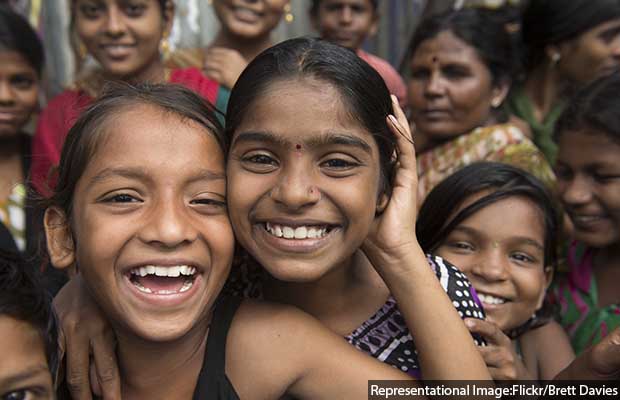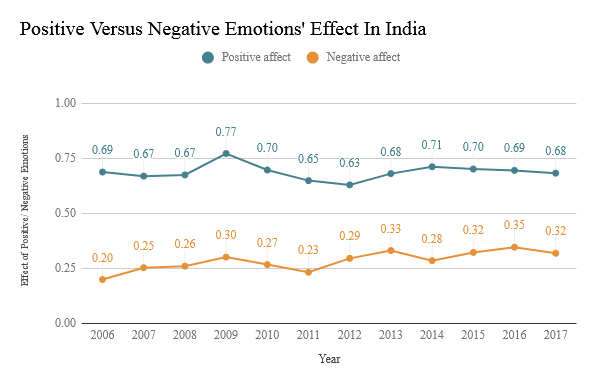Mount Abu, Rajasthan: India has been ranked 133rd among 156 countries in the United Nations’ (UN) World Happiness Report 2018, 15 places down from its position in 2015.

This is despite the report’s finding that India’s per capita gross domestic product (GDP), a measure of the standard of living, and healthy life expectancy, a marker of wellbeing, have trended upwards over the last three years.
Source: World Happiness Report 2018
Further, participants surveyed during 2017 for the current report expressed greater satisfaction with their personal freedom–the freedom to make life choices–as well as greater confidence in their national government.
Then what makes Indians less happy today than they were three years ago? And why are Indians the least happy people in the Indian subcontinent? Myanmar (130), Sri Lanka (116), Bangladesh (115), Nepal (101), Bhutan (97) and Pakistan (75) all rank higher than India, while neighbouring China stands at 86.
Indians are suffering the impact of weaker social support networks, a less generous society, and fewer reasons to experience positive emotions such as laughter, at a time when they are feeling more negative emotions such as worry and anger, social scientists have told IndiaSpend. At the same time, socio-economic inequity is preventing per capita GDP growth from translating into happier people.
Why higher per capita GDP has not made Indians happier
In July 2011, a UN General Assembly resolution recognised that “the gross domestic product indicator by nature was not designed to and does not adequately reflect the happiness and well-being of people”. It invited member-nations to develop measures to better reflect the pursuit of happiness and wellbeing to guide public policy.
Since 2012, with the exception of 2014, the UN has been publishing a report on the state of happiness in countries around the world, remarking on the causes of happiness and misery, and their policy implications, primarily based on the Gallup World Poll that specialises in tracking citizens’ opinions.
India recorded a higher growth rate in real GDP at constant prices between 2014-15 and 2016-17 than in the previous three years from 2011-12 to 2013-14, according to data from the World Bank.
| India’s GDP/ Per Capita GDP Rising | |||
|---|---|---|---|
| Year | Real GDP Growth Rate | Log GDP Per Capita (WHR 2018) | World Happiness Ranking |
| 2012 | 6.60% | 8.48 | 111 |
| 2013 | 5.50% | 8.53 | 111 |
| 2014 | 6.40% | 8.59 | 117 |
| 2015 | 7.50% | 8.66 | 118 |
| 2016 | 8.00% | 8.71 | 122 |
| 2017 | 7.10% | 8.77 | 133 |
Source: World Happiness Report 2018, World Bank
Per capita GDP is frequently used as an indicator of standard of living. However, that only works in a society where the distribution of income and wealth is reasonably equitable.
“In India, income, wealth or other forms of human capital inequalities are starkly visible,” Hema Swaminathan, chairperson of the Centre for Public Policy at the Indian Institute of Management, Bangalore, told IndiaSpend.
“Here, an accident of birth decides your life’s prospects, and with the steady erosion of the structures that could help individuals achieve mobility, such as the primary education system and public health system, little scope exists for social or economic mobility,” she said.
While per capita GDP is rising, socio-economic inequality is, too. In 2014, India recorded the widest income inequality since 1980, according to a report by the World Inequality Lab.
In 2013, 390 million Indians, making up the bottom half of India’s earning population, earned 67% of the share of the top 1%, which consisted of 7.8 million people. In 1980, India’s bottom 50% had earned 319% of the income of the richest 1%.
Social inequities militate against happiness, as a seminal study on the topic showed in 1970s U.S. Richard Easterlin, a professor of economics at the University of Southern California, showed how increases in income from 1946 to 1970 coincided with flat levels of reported happiness.
Recent data from the U.S. bear out this association, economist Jeffrey Sachs, co-editor of the World Happiness Report 2018, noted in the report. He added that absolute increases do matter for happiness, “albeit with a clearly declining marginal utility of income”.
More recently, scientists from the London School of Economics and Political Science examined data from the Gallup World Poll and the World Top Incomes Database and found that the more income is held by the richest 1% of a nation, the more likely individuals are to report lower levels of wellbeing, life satisfaction and more negative daily emotional experiences.
This is not to say that higher income does not matter. Very poor people, when their income increases, become happier as their basic needs are met. However, once these needs are fulfilled, they stop experiencing greater happiness with rising income if there is also growing inequality, as it leads to unfavourable comparisons, said Shreya Jha, a doctoral candidate in Social and Policy Sciences at the University of Bath, U.K., who has studied well-being in the Indian context.
Indians worry more, feel sadder and angrier
In the last three years, Indians have reported experiencing fewer positive emotions and more negative emotions, two variables that influence World Happiness rankings.
Did you experience happiness and enjoyment during a greater part of yesterday? Did you smile or laugh a lot yesterday? Participants’ responses to these questions made up the positive emotion variable, called ‘positive affect’.
To what extent did you experience worry, sadness and anger yesterday? Participants’ responses to these questions made up the negative emotions variable, called the ‘negative affect’.
In India, the effect of positive emotions has been reducing since 2015, while the effect of negative emotions has been increasing as compared with the previous three years (2012-2014), the World Happiness Report shows. This means that Indians perceive fewer reasons to smile and more reasons to worry and feel angry.
Research suggests that negative circumstances could have a stronger effect on our emotions, Jha said, adding, “Essentially, negative circumstances take precedence in our attention especially when there are no other factors that can alleviate their negative effects.”

Source: World Happiness Report 2018
Social scientists believe the current political climate can partly explain the current mood of gloom in the country.
“In the current political climate, prominent identity qualifiers such as caste, religion and gender are being stoked for short-term gains,” Swaminathan said, “The ensuing negative emotions of distrust, hate, prejudices and so on against the ‘other’ are not conducive to a state of happiness.”
At the same time, fewer Indians reported having someone to count on to help tide over troubled times in 2017, the World Happiness Report noted.
“It is known that relationships both in the family and broader environment affect happiness,” Jha said.
Greater confidence in government, yet perception of greater corruption
Indian citizens surveyed in 2017 for this year’s happiness report expressed greater confidence in the national government than in the previous few years. Trust in the government is a measure of social capital, or the quantity and quality of social relations in a community, to cite the first World Happiness Report, which also concluded that trust adds to life satisfaction.
But Indians also reported perceiving greater corruption in government and business, which seems to take away from their happiness gains.
Sweeping measures such as demonetisation and implementation of the Goods and Services Tax made people think this government was capable of taking bold steps to improve the economy, Swaminathan said. People thought corruption would reduce, at least in the ordinary transactions involving the common person. However, with new scams unfolding, that perception has changed.
Confidence in this government is still high, Swaminathan said, because this government has a sophisticated marketing machinery and an active public relations network that gives the impression of a system that is responsive to citizens.
Why India must measure its people’s happiness
Happiness is a subjective feeling. However, that is not to say that it is immeasurable or that the government should brush it aside as irrelevant to public policy. Happiness is, after all, everyone’s life goal.
“Some Indian states are already starting happiness surveys, but national coordination would be invaluable,” John F. Helliwell, co-editor of World Happiness Report 2018, told IndiaSpend.
In 2017, the Madhya Pradesh state government declared it would gauge the happiness quotient of its people, the maiden such initiative by an Indian state. Chief minister Shivraj Singh Chouhan said feedback from the happiness survey would be “factored into our government policies and public expenditure priorities”.
“You should petition your statistical agency to start measuring satisfaction with life in surveys large enough to show how life is going in different states, and for people in different life circumstances,” said Helliwell, who is professor emeritus at the University of British Columbia and senior fellow at the Canadian Institute for Advanced Research. “Then you and we could see more clearly why the Indian ranking as a whole has fallen relative to others in recent years,” he said.
(Bahri is a freelance writer and editor based in Mount Abu, Rajasthan.)
Courtesy: India Spend